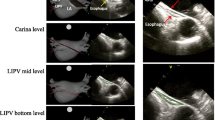Abstract
Purpose:
The aim of this study was to investigate the anatomic relationship around the left atrium (LA) and to provide clinical information to help avoid the risk of an atrio-esophageal fistula during atrial fibrillation (AF) ablation.
Methods:
The multidetector spiral computed tomography images of 77 male patients (mean age, 54 ± 9 years) with drug-refractory AF and 37 male control subjects (mean age, 50 ± 11 years) were analyzed. We measured the following variables: (1) distance between the ostia of the pulmonary veins (PVs) and the ipsilateral esophageal border, (2) presence of a pericardial fat pad around each PV, and (3) contact width/length and presence of a fat pad between the LA and the esophagus.
Results:
The distance between the esophagus and the ostia of right superior PV, right inferior PV (RIPV), left superior PV, and left inferior PV (LIPV) was 27.2 ± 9.4 mm, 22.9 ± 10.3 mm, 2.7 ± 9.4 mm, and 7.1 ± 8.8 mm, respectively. A fat pad between the esophagus and the superior PV was present in more than 90% of the subjects in both groups. However, the fat pad around inferior PV was present less frequently in the patients than in the control group (p = 0.011, RIPV; p < 0.001, LIPV). The average length of the LA–esophagus contact in the patients and the control group subjects was 26.2 ± 10.4 and 18.5 ± 5.1 mm, respectively (p < 0.001).
Conclusion:
Caution should be exercised when ablating the LIPV because the esophagus is located in close proximity to the left-sided PV and most of the inferior PVs in patients with AF are not covered with fat pads.

Similar content being viewed by others
References
Fuster, V., Ryden, L. E., Cannom, D. S., Crijns, H. J., Curtis, A. B., Ellenbogen, K. A., et al. (2006). ACC/AHA/ESC 2006 guidelines for the management of patients with atrial fibrillation—executive summary: a report of the American College of Cardiology/American Heart Association Task Force on Practice Guidelines and the European Society of Cardiology Committee for Practice Guidelines (Writing Committee to Revise the 2001 Guidelines for the Management of Patients With Atrial Fibrillation). Journal of the American College of Cardiology, 48(4), 854–906.
Cappato, R., Calkins, H., Chen, S. A., Davies, W., Iesaka, Y., Kalman, J., et al. (2009). Prevalence and causes of fatal outcome in catheter ablation of atrial fibrillation. Journal of the American College of Cardiology, 53(19), 1798–1803.
Ghia, K. K., Chugh, A., Good, E., Pelosi, F., Jongnarangsin, K., Bogun, F., et al. (2009). A nationwide survey on the prevalence of atrioesophageal fistula after left atrial radiofrequency catheter ablation. Journal of Interventional Cardiac Electrophysiology, 24(1), 33–36.
Pappone, C., Oral, H., Santinelli, V., Vicedomini, G., Lang, C. C., Manguso, F., et al. (2004). Atrio-esophageal fistula as a complication of percutaneous transcatheter ablation of atrial fibrillation. Circulation, 109(22), 2724–2726.
Scanavacca, M. I., D'Avila, A., Parga, J., & Sosa, E. (2004). Left atrial-esophageal fistula following radiofrequency catheter ablation of atrial fibrillation. Journal of Cardiovascular Electrophysiology, 15(8), 960–962.
Cummings, J. E., Schweikert, R. A., Saliba, W. I., Burkhardt, J. D., Kilikaslan, F., Saad, E., et al. (2006). Brief communication: atrial-esophageal fistulas after radiofrequency ablation. Annals of Internal Medicine, 144(8), 572–574.
Han, J., Good, E., Morady, F., & Oral, H. (2004). Images in cardiovascular medicine. Esophageal migration during left atrial catheter ablation for atrial fibrillation. Circulation, 110(24), e528.
Cummings, J. E., Schweikert, R. A., Saliba, W. I., Burkhardt, J. D., Brachmann, J., Gunther, J., et al. (2005). Assessment of temperature, proximity, and course of the esophagus during radiofrequency ablation within the left atrium. Circulation, 112(4), 459–464.
Tsao, H. M., Wu, M. H., Higa, S., Lee, K. T., Tai, C. T., Hsu, N. W., et al. (2005). Anatomic relationship of the esophagus and left atrium: implication for catheter ablation of atrial fibrillation. Chest, 128(4), 2581–2587.
Helms, A., West, J. J., Patel, A., Mounsey, J. P., DiMarco, J. P., Mangrum, J. M., et al. (2009). Real-time rotational ICE imaging of the relationship of the ablation catheter tip and the esophagus during atrial fibrillation ablation. Journal of Cardiovascular Electrophysiology, 20(2), 130–137.
Gilcrease, G. W., & Stein, J. B. (2010). A delayed case of fatal atrioesophageal fistula following radiofrequency ablation for atrial fibrillation. Journal of Cardiovascular Electrophysiology, 21(6), 708–711.
Lemola, K., Sneider, M., Desjardins, B., Case, I., Han, J., Good, E., et al. (2004). Computed tomographic analysis of the anatomy of the left atrium and the esophagus: implications for left atrial catheter ablation. Circulation, 110(24), 3655–3660.
Monnig, G., Wessling, J., Juergens, K. U., Milberg, P., Ribbing, M., Fischbach, R., et al. (2005). Further evidence of a close anatomical relation between the oesophagus and pulmonary veins. Europace, 7(6), 540–545.
Chugh, A., Rubenstein, J., Good, E., Ebinger, M., Jongnarangsin, K., Fortino, J., et al. (2009). Mechanical displacement of the esophagus in patients undergoing left atrial ablation of atrial fibrillation. Heart Rhythm, 6(3), 319–322.
Singh, S. M., d’Avila, A., Doshi, S. K., Brugge, W. R., Bedford, R. A., Mela, T., et al. (2008). Esophageal injury and temperature monitoring during atrial fibrillation ablation. Circulation. Arrhythmia and Electrophysiology, 1(3), 162–168.
Tsuchiya, T., Ashikaga, K., Nakagawa, S., Hayashida, K., & Kugimiya, H. (2007). Atrial fibrillation ablation with esophageal cooling with a cooled water-irrigated intraesophageal balloon: a pilot study. Journal of Cardiovascular Electrophysiology, 18(2), 145–150.
Buch, E., Nakahara, S., & Shivkumar, K. (2008). Intra-pericardial balloon retraction of the left atrium: a novel method to prevent esophageal injury during catheter ablation. Heart Rhythm, 5(10), 1473–1475.
Author information
Authors and Affiliations
Corresponding author
Rights and permissions
About this article
Cite this article
Jang, SW., Kwon, BJ., Choi, MS. et al. Computed tomographic analysis of the esophagus, left atrium, and pulmonary veins: implications for catheter ablation of atrial fibrillation. J Interv Card Electrophysiol 32, 1–6 (2011). https://doi.org/10.1007/s10840-011-9594-9
Received:
Accepted:
Published:
Issue Date:
DOI: https://doi.org/10.1007/s10840-011-9594-9




